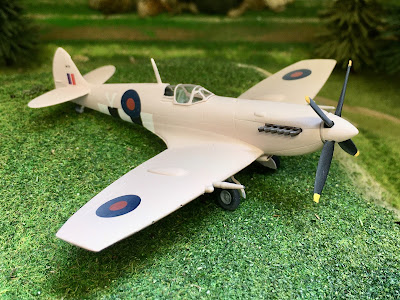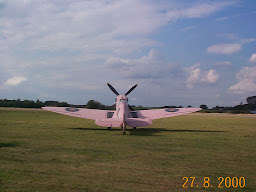After dropping down to terre ferme for a few tracked vehicle builds, inspired as I was by the D-Day anniversary and the part these landships played in liberating France from Nazi tyranny, my latest build returns to the air. This scale model is of one of the most iconic aircraft of WW2, but obviously with a twist.
This is the Supermarine Spitfire FR.IXc, MK716, in the colours of 16 Sqn, No.34 (Reconnaissance) Wing based near Bayeaux, France, during September 1944. And yes, it is pink and has stubby wings! MK716 was one of only 15 Mk. IX Spitfires converted to the pale pink scheme to fly high risk low level photo reconnaissance missions, pictorially recording the location and configuration of German military defences pre and post the D-Day landings.
And for those who are interested, here is the extended back story ...
The idea of using a fast fighter for reconnaissance had been proposed before the outbreak of war, however, there were too few aircraft available to be spared for non-combat operations; or at least that was until on 22 September 1939, Sidney Cotton, an Australian inventor, adventurer, aviation and photography pioneer, was commissioned to set up the RAF's 1 Photographic Development Unit (PDU). In October 1939, Sidney was provided with two Spitfire Mk Is to develop as photo reconnaissance aircraft. These two aircraft were the first of around one thousand Spitfires to be either converted or built from scratch for the reconnaissance role. This short ranged fighter would roam as far as Berlin, providing the Allied armies with vital intelligence throughout the war.
 |
| Rare colour picture of 16 Sqn's FR.IXc Spitfires |
The first Spitfire flown high-speed, high-altitude photo-reconnaissance (PR) mission of the war took place on 18 November 1939 when Flt. Lt. "Shorty" Longbottom took off from Seclin and attempted to photograph Aachen from 33,000 ft. Flying PR missions was not an easy assignment, Spitfire pilots often flew missions lasting at least a full working day, in today's money, in a freezing cramped cockpit. The introduction of heating and, later in the war, pressurisation, was to pilots a luxury which made the job a little more bearable. Early PR Spitfires also lacked radios but, even when added in later versions, the pilot was expected to maintain radio silence throughout the flight. If you have ever seen the classic 1953 movie The Malta Story where Alec Guinness plays the role of a Spitfire PR pilot, you'll understand why radio science was so important!
A number of various paint schemes were used by the early photo-reconnaissance Spitfires with an overall "PRU Blue" being adopted for the majority of medium to high altitude aircraft. Spitfires engaged in low altitude missions were often painted in a very pale "Camoutint Pink", which was found to provide the ideal camouflage when viewed against low cloud or during dawn and dusk when the sun is low and the sky can have a pink hue.
 |
| Mk IX, the RAF's most heavily armed reconnaissance Spitfire |
Low-altitude PR sorties, called "dicing" missions, were required to photograph specific and smaller targets such as radar stations, V1 launch sites and defensive positions, were obviously much more dangerous than those at high-altitude. At high speed and low altitude there was also little time to aim the oblique camera and the pilot had to become skilful in estimating when best to start taking photographs. This was not a job for the faint hearted!
My Spitfire depicts one of these low level PR specialists but with 2 unique features; not counting its pink camouflage! Its first unusual attribute is that this was the most heavily armed reconnaissance Spitfire, the IXc. Produced in small numbers, rather than having all its guns stripped out as was more common for a PDU Spitfire, the IXc carried the standard armament of the Mk IX fighter, with one rather than two obliquely mounted F.24 cameras housed in the fuselage over the pilot's left shoulder.
The second unique feature is its clipped wings. Clipping a Spitfire's wings is often questioned from an aesthetic perspective and this is why you'll probably never see many in this trim flying at airshows, the classic elliptical wing being regarded by many as the key to its beauty. So why clip a Spitfire's wings? In August 1941, long after the Spitfires had won the Battle of Britain against the Messerschmitt Me109, a new Luftwaffe fighter appeared in the sky over Europe. This was the Focke-Wulf Fw190, which owing to its incredible rate of roll and manoeuvrability, soon proved to have superiority over even the Spitfire. Something had to be done to stem the losses being suffered. Aircraft engineers identified that in order increase the roll rate and improve its combat fighting qualities, the wingspan needed to be shortened. Fortunately, the Spitfire's wingtips are a separate construction, attached with few bolts and a number of small screws. It was thus an obvious and easy solution to simply remove the wingtips and fit a fairing in its place.
 |
| Non clipped wing version in flight |
In a test flight performed between a standard winged Spitfire Mk V and the new shortened version at various heights up to 25,000 feet, it was discovered that the clipped wing made the aircraft 5mph faster at 10,000 feet and gave an improved acceleration across all tests. In a dive, the clipped wing Spitfire could pull away from the standard version and most critically, in a dogfight its improved roll rate meant it could shake off the pursuing unmodified Spitfire. There was minimal change in climb performance and with no noticeable change to the take-off and landing performance the shortened wing was a winner. There was also another benefit to the PR pilot. The Spitfire wing is quite large and actually blocks out a lot of the ground from the pilot’s view, so as the removal of the wingtips shaved over four feet from each side, it improved his downward view considerably.
Performance improvements were so noticeable that it was not surprising that during the latter stages of the war the clipped wing configuration became a very common sight. Indeed, it was almost the standard specification on all later Spitfire variants, particularly as high altitude sorties became fewer and low level missions, such as ground strafing and photo reconnaissance, became the priority.
Finally, here are a couple of amateur shots of a rather brighter than original pink, later Spitfire Mk PRXI that I found in my photo archive from a Duxford Airshow 20 years ago.







No comments:
Post a Comment
Note: only a member of this blog may post a comment.